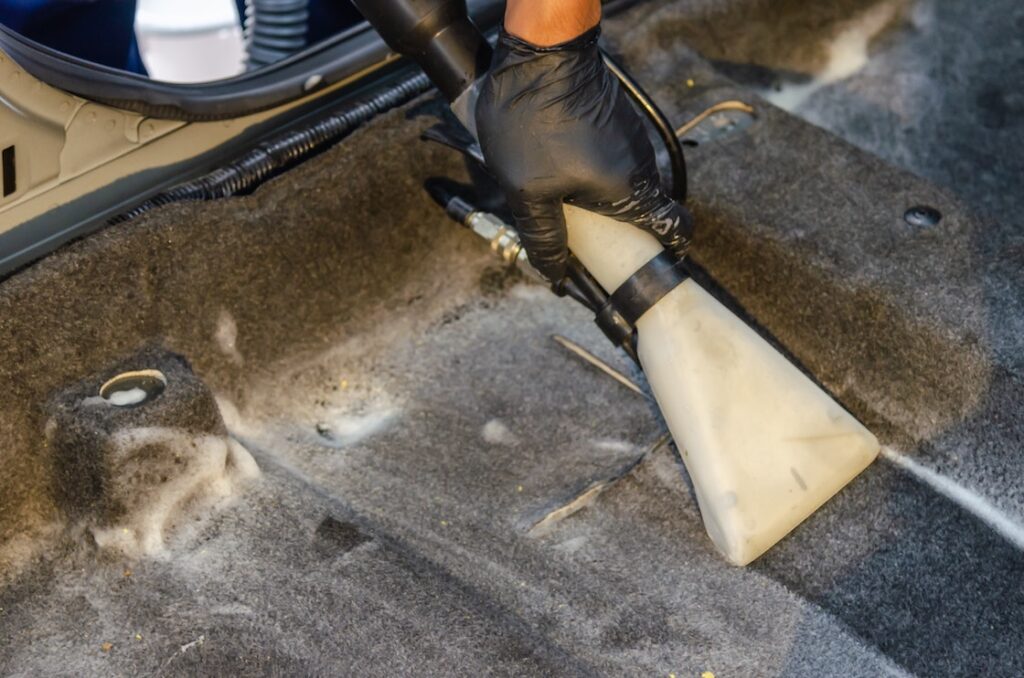While it’s certainly never fun to discover mold in your car, it doesn’t mean that you need to panic.
More often than not, you’ll be able to remove the fungus yourself, and even with a severe infestation, professionals should be capable of handling it for you. The sooner you act, though, the simpler it should be to return your vehicle to a clean, mold-free state.
How do you end up with mold in your car?
If you know much about mold, you probably know that it requires moisture to grow. So, if the fungus has suddenly shown up in your car, it means that some sort of liquid has made its way into the vehicle’s interior.
Most commonly, mold growth in a car will be caused by something as ordinary as a spilled water bottle or other beverage.
Other times, it can be the result of wet clothes being left sitting on the seats or leaving the windows open while it’s raining. In some cases, simply leaving the windows cracked in an area of extreme humidity can lead to mold appearing.
If your car is harboring mold, it could also be possible that there’s a leak somewhere around the vehicle. When a car has one or more significant water leaks, it may take nothing more than a single heavy rainstorm for mold to arrive and flourish—even without you leaving the windows open.
How do you clean mold out of your car?
Provided that your car’s mold infestation isn’t too out of hand or dug into your interior, you should be able to clean it on your own. Before you even think about starting the job, though, you need to equip yourself with the proper safety gear. Whenever you’re working with mold, you should be wearing rubber gloves, goggles, and a face mask.
When you’re ready to begin, you’ll want to park your car on a flat surface in a well-ventilated area, then remove your personal belongings from the affected part of the car.
You should also remove anything from the interior that could be the source of moisture, such as wet clothing, mats, or seat covers.
To keep yourself as safe as possible from breathing in mold spores, you may want to let your car sit with the windows down for a bit before you start cleaning.
For the cleaning method itself, there are a few items you’ll want to have:
- Spray bottle
- Dry towels or rags
- A bristled scrub brush
- Wet-and-dry vacuum cleaner
- White vinegar solution (4 parts water to 1 part vinegar is a good blend)
The process itself is pretty straightforward. After filling your spray bottle with the vinegar solution, spray it generously on the moldy spot(s) in your car.
Once you’ve covered the mold with the solution, scrub the area lightly to ensure that it gets thoroughly worked into the surface. Then, let the area sit and dry for about 20 to 30 minutes.
Finally, use the wet-and-dry vacuum to clean up the remaining dead mold, and you’re done! The only downside to this method is the potential for a lingering vinegar smell, which you may need to remedy with an air freshener or by letting the car air out for a while.
While the white vinegar method is one of the most common for cleaning mold from a vehicle, it isn’t the only one that works. If you prefer a method that leaves behind a fresher scent, you can instead douse the mold growth with baking soda, let it sit for a while, then vacuum the residue up.
Alternatively, you can use the white vinegar method outlined above but replace the vinegar with a salt-water solution. However, salt can potentially eat away at leather or leave stains behind, so it should probably be the last resort.
When should you call in a professional?
Unfortunately, some mold infestations are just too large or stubborn for you to effectively remove on your own. In those cases—assuming you want to continue driving the car—you need to enlist the help of mold removal professionals.
If the mold in your car fits any of the following criteria, you should leave it to a professional service:
- Mold keeps coming back after removal
- Multiple colors of mold spread out in a splash pattern
- Stale, moldy odor persists after removing the visible mold
- You’re feeling lightheaded, nauseous, or short of breath when in the car
In these situations, it would be unwise for you to make further attempts at cleaning the fungus yourself. Mold removal experts will have the knowledge and equipment necessary to fight the most persistent and expansive infestations, and they’ll have you back on the road in a clean vehicle as quickly as possible.


